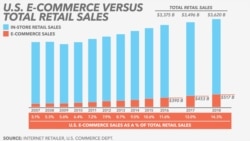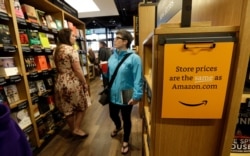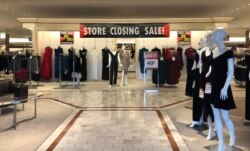If you think online sales are poised to take over in-store purchases anytime soon, think again.
Although the retail landscape in the United States can look dire — with many malls and individual retailers closing up shop — the reality is that just 11% of all retail sales occur online. A full 89% of all retail purchases happen the traditional way, by walking into a store, according to the U.S. Department of Commerce.
When you factor out goods that aren’t usually bought online, such as gas, vehicles and restaurant food, virtual purchases account for 14.3% of total retail sales. Over the last decade, there’s been just under 1% annual growth in online retailing versus conventional retailing.
“(There’s a) misconception that online retailers are taking over. Online retailers are not taking over,” says James E. Schrager, professor of entrepreneurship and strategy at the University of Chicago Booth School of Business. “Online retail is growing at a fairly modest, measured pace. It will continue to grow, but it's running into huge hurdles everywhere it goes.”
Schrager says the profit margin is “wildly lower” for online sales versus conventional sales.
“If it (online sales) was going to explode, it would have exploded a long time ago,” he says. “The barriers of shipment, of the cost of warehousing, the cost of return, are just staggering.”
Amazon doesn’t share all of its numbers, but the fact that the nation’s largest and most successful online retailer recently bought Whole Foods, a chain of brick and mortar grocery stores, suggests the e-commerce giant sees some value in traditional retailing. Amazon has also opened 21 brick and mortar bookstores across the nation.
The net numbers that are available from bookseller Barnes & Noble, as well Walmart online sales, suggest they’re all losing money, according to Schrager.
“Walmart is a dominant retailer in the United States. Walmart makes tons and tons of money in brick and mortar (stores),” he says. “Walmart was the ideal folks to go online and prove whether or not you can make money selling new things online or not. And Walmart doesn't make money selling new things online.”
More than 9,300 stores have closed so far in 2019, according to an analysis by Business Insider. That includes 2,500 Payless shoe stores, 805 Gymboree kids’ clothing stores, 650 Dress Barn stores, and 520 Charlotte Russe clothing stores.
If online shopping isn’t doing catastrophic damage to brick-and-mortar shops, then what explains all of the closings? One answer could be oversaturation. For example, there are 48 retail square feet per person in the United States, compared to 22 per person in Britain and 13 per person in Canada, according to Cowen and Company research.
While the number of physical stores shrinks in response to demand, e-retailers are likely to continue looking for ways to make money from online sales.
For now, there is one place online selling is truly booming and that is when it comes to used goods, according to Schrager. Virtual garage sales are advantageous to both the seller, who reaches more people online than they might by setting up shop on their driveway, and the buyer, who can cover lots of ground online, all from the comfort of home.











